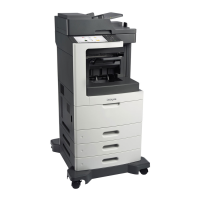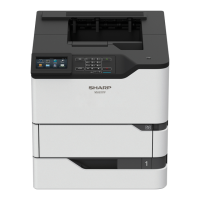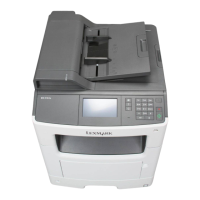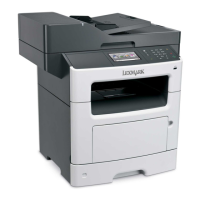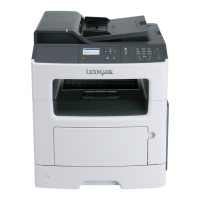How to fix Lexmark MX510 Printer 'Non-Lexmark [supply type]' error?
- BBobby ColeSep 3, 2025
To resolve the 'Non-Lexmark' error on your Lexmark Printer, remove the third-party supply or part and install a genuine Lexmark supply or part.
How to fix Lexmark MX510 Printer 'Non-Lexmark [supply type]' error?
To resolve the 'Non-Lexmark' error on your Lexmark Printer, remove the third-party supply or part and install a genuine Lexmark supply or part.
What to do if my Lexmark All in One Printer has a scanner jam?
To fix a scanner jam on your Lexmark All in One Printer, remove the jammed paper from the scanner.
How to clear 'Cartridge low' message on Lexmark All in One Printer?
Your Lexmark All in One Printer indicates that the toner cartridge is low. You may need to order a new toner cartridge. If you wish to continue printing, select Continue on the printer control panel to clear the message.
What to do if Lexmark MX510 Printer displays 'Fax server 'To Format' not set up'?
If your Lexmark Printer displays 'Fax server 'To Format' not set up', select 'Continue' on the printer control panel to clear the message. Then, complete the Fax Server setup.
What does 'Supply needed to complete job' mean on Lexmark All in One Printer?
To resolve this issue on your Lexmark All in One Printer, install the missing supply to complete the job, or cancel the current job.
What to do if Lexmark Printer displays 'Not enough free space in flash memory for resources'?
If your Lexmark Printer displays 'Not enough free space in flash memory for resources', select 'Continue' on the printer control panel to clear the message and continue printing. Alternatively, delete fonts, macros, and other data stored in the flash memory, or upgrade to a larger capacity flash memory card.
What to do if Lexmark MX510 says 'Cartridge low'?
If your Lexmark Printer displays a 'Cartridge low' message, you may need to order a new toner cartridge. To clear the message and continue printing, select 'Continue' on the printer control panel, if necessary.
What does 'Too many trays attached' mean on Lexmark All in One Printer?
To resolve this issue on your Lexmark All in One Printer: 1. Turn off the printer. 2. Unplug the power cord from the electrical outlet. 3. Remove the extra trays. 4. Connect the power cord to a properly grounded electrical outlet. 5. Turn the printer back on.
How to load manual feeder on Lexmark All in One Printer?
To solve this problem with your Lexmark All in One Printer, load the multipurpose feeder with the correct size of paper. Depending on your printer model, you can also touch Continue or press to clear the message and continue printing, or cancel the current job.
What to do when Lexmark All in One Printer says 'Imaging unit very low'?
Your Lexmark All in One Printer indicates that the imaging unit is very low and may need replacement soon. Select Continue on the printer control panel to clear the message and continue printing.
Crucial warnings for safe operation, including electrical hazards, hot surfaces, and potential injury.
Guide to locating setup, user, and networking documentation for the printer.
Recommendations for optimal printer placement, including environmental and space considerations.
Information on how to configure the printer, including adding optional trays for stability.
Overview of the printer's scanning capabilities and basic operations.
Instructions for using the Automatic Document Feeder and scanner glass for scanning tasks.
Overview of the printer's control panel buttons and their functions for operation.
Explanation of the meanings behind the colors of the Sleep button and indicator lights.
Explanation of the printer's home screen interface, icons, and navigation.
Instructions for finding computer IP addresses required for network application setup.
Guide to accessing the printer's web interface for configuration and management.
Overview of the various home screen applications available on the printer.
Details on installing optional hardware components like memory cards and network ports.
Instructions for installing physical hardware options, including trays and spacers.
Guidance on connecting necessary cables for printer operation and network connectivity.
Steps for installing printer software and updating driver options for full functionality.
Information needed before setting up an Ethernet network connection for the printer.
Details required for configuring a wireless network connection for the printer.
Instructions for setting paper dimensions and type in trays for optimal printing.
Step-by-step guide on how to properly load paper into the printer trays.
Instructions for loading various paper types and specialty media into the multipurpose feeder.
How to configure trays to automatically link or unlink for paper feeding.
Tips and guidelines for using letterhead, transparencies, envelopes, labels, and card stock.
Information on paper characteristics affecting print quality and reliability.
Guidelines for storing paper properly to avoid jams and ensure print quality.
Procedures for printing standard documents and frequently used forms.
Steps to print documents directly from a USB flash drive.
How to store, manage, and print secure or held print jobs.
Instructions for printing various printer information pages.
Methods for canceling print jobs from the computer or printer control panel.
Instructions for performing quick copies and using ADF or scanner glass.
How to adjust settings like size, darkness, and collating for copies.
Guide to copying documents with varying paper sizes, including auto-size matching.
Instructions for performing double-sided copies from single or double-sided originals.
How to stack printed pages in sequence for multiple copies of a document.
Options for adding headers, footers, or overlay messages to copied pages.
Methods for canceling copy jobs during various stages of the copying process.
Steps to configure the printer for sending scanned documents via email.
How to create shortcuts for frequent email recipients and settings.
Methods for sending scanned documents via email using different options.
Options for customizing email subject, message, file type, and other settings.
Initial setup procedures for enabling and configuring the printer's fax capabilities.
Information required for outgoing faxes, including sender identification and fax number.
Various scenarios for connecting the printer to different telephone line types.
Methods for sending faxes using the printer control panel or computer.
How to adjust fax resolution, darkness, and other transmission parameters.
Options for holding received faxes or forwarding them to other destinations.
Guide to scanning documents directly to network destinations like shared folders.
Instructions for scanning documents to an FTP server.
Methods for scanning documents directly to a computer or USB flash drive.
Overview of options for scan settings like format, resolution, and darkness.
A comprehensive list and overview of all available printer menus and their functions.
Settings related to paper sources, sizes, types, and loading configurations.
How to print various reports detailing printer status, network settings, and logs.
Configuration options for network card, IP settings, and standard network interfaces.
Settings related to printer security, login restrictions, and confidential print jobs.
General settings for display language, eco-modes, quiet mode, and keyboard configuration.
Detailed descriptions of various print settings available for customization.
Settings for adjusting print resolution, pixel boost, and toner darkness.
Features for tracking and managing print jobs, including logging and utilities.
Options for managing held jobs, formatting flash memory, and activating hex trace.
Access to built-in help pages covering printer usage and tasks.
Tips and strategies for reducing paper and toner consumption for cost and environmental benefits.
Methods to save energy through Sleep Mode, Hibernate Mode, and display brightness settings.
Information on Lexmark's recycling programs for products and cartridges.
Explanation of the types of memory in the printer and data storage.
How to erase sensitive data from the printer's volatile memory.
Secure methods to overwrite and erase data from the printer's hard disk.
Steps to enable hard disk encryption for data protection.
Instructions for cleaning the printer's exterior and internal components.
Guide for cleaning the scanner glass and ADF glass to improve image quality.
How to check the status of printer components and consumables.
Information on how to order toner cartridges, imaging units, and maintenance kits.
Step-by-step instructions for replacing the toner cartridge.
Detailed steps for replacing the printer's imaging unit.
Precautions and steps for safely moving the printer.
Resources for advanced system support and network management tasks.
How to configure email notifications for supply levels and printer status.
Procedures for resetting printer settings to factory defaults.
Tips and best practices for preventing paper jams by proper loading.
How to interpret jam messages and identify locations for clearing jams.
Specific steps to clear paper jams located behind the front door.
Specific steps to clear paper jams found behind the rear door.
Steps to clear paper jams from the standard output bin.
A guide to common printer error and status messages and their resolutions.
Troubleshooting steps for common issues like the printer not responding or display being blank.
Solutions for issues related to internal options, ports, and interface cards.
Troubleshooting steps for issues like jammed pages, frequent jams, and tray linking.
Guidance for resolving issues where jobs do not print, print slowly, or have quality problems.
Diagnosis and solutions for common print quality issues like jagged edges, clipped images, and density problems.
Troubleshooting steps for when the copier does not respond or produces poor quality copies.
Solutions for issues related to fax setup, sending, receiving, and print quality.
Troubleshooting steps for scanner issues like not scanning, poor image quality, or unit not closing.
Guidance for resolving errors or issues with printer home screen applications.
Details about the product name, machine type, and model numbers.
Regulatory compliance statement regarding FCC rules for digital devices.
Information regarding the terms and conditions of the product's limited warranty.
Detailed explanation of what the limited warranty covers and excludes.
Legal information about patents related to the product's technology.
Documentation of the product's power consumption characteristics in various modes.
Explanation of the energy-saving Sleep Mode and its timeout settings.
Description of the ultra-low power Hibernate Mode and how it can be entered.
Crucial warnings for safe operation, including electrical hazards, hot surfaces, and potential injury.
Guide to locating setup, user, and networking documentation for the printer.
Recommendations for optimal printer placement, including environmental and space considerations.
Information on how to configure the printer, including adding optional trays for stability.
Overview of the printer's scanning capabilities and basic operations.
Instructions for using the Automatic Document Feeder and scanner glass for scanning tasks.
Overview of the printer's control panel buttons and their functions for operation.
Explanation of the meanings behind the colors of the Sleep button and indicator lights.
Explanation of the printer's home screen interface, icons, and navigation.
Instructions for finding computer IP addresses required for network application setup.
Guide to accessing the printer's web interface for configuration and management.
Overview of the various home screen applications available on the printer.
Details on installing optional hardware components like memory cards and network ports.
Instructions for installing physical hardware options, including trays and spacers.
Guidance on connecting necessary cables for printer operation and network connectivity.
Steps for installing printer software and updating driver options for full functionality.
Information needed before setting up an Ethernet network connection for the printer.
Details required for configuring a wireless network connection for the printer.
Instructions for setting paper dimensions and type in trays for optimal printing.
Step-by-step guide on how to properly load paper into the printer trays.
Instructions for loading various paper types and specialty media into the multipurpose feeder.
How to configure trays to automatically link or unlink for paper feeding.
Tips and guidelines for using letterhead, transparencies, envelopes, labels, and card stock.
Information on paper characteristics affecting print quality and reliability.
Guidelines for storing paper properly to avoid jams and ensure print quality.
Procedures for printing standard documents and frequently used forms.
Steps to print documents directly from a USB flash drive.
How to store, manage, and print secure or held print jobs.
Instructions for printing various printer information pages.
Methods for canceling print jobs from the computer or printer control panel.
Instructions for performing quick copies and using ADF or scanner glass.
How to adjust settings like size, darkness, and collating for copies.
Guide to copying documents with varying paper sizes, including auto-size matching.
Instructions for performing double-sided copies from single or double-sided originals.
How to stack printed pages in sequence for multiple copies of a document.
Options for adding headers, footers, or overlay messages to copied pages.
Methods for canceling copy jobs during various stages of the copying process.
Steps to configure the printer for sending scanned documents via email.
How to create shortcuts for frequent email recipients and settings.
Methods for sending scanned documents via email using different options.
Options for customizing email subject, message, file type, and other settings.
Initial setup procedures for enabling and configuring the printer's fax capabilities.
Information required for outgoing faxes, including sender identification and fax number.
Various scenarios for connecting the printer to different telephone line types.
Methods for sending faxes using the printer control panel or computer.
How to adjust fax resolution, darkness, and other transmission parameters.
Options for holding received faxes or forwarding them to other destinations.
Guide to scanning documents directly to network destinations like shared folders.
Instructions for scanning documents to an FTP server.
Methods for scanning documents directly to a computer or USB flash drive.
Overview of options for scan settings like format, resolution, and darkness.
A comprehensive list and overview of all available printer menus and their functions.
Settings related to paper sources, sizes, types, and loading configurations.
How to print various reports detailing printer status, network settings, and logs.
Configuration options for network card, IP settings, and standard network interfaces.
Settings related to printer security, login restrictions, and confidential print jobs.
General settings for display language, eco-modes, quiet mode, and keyboard configuration.
Detailed descriptions of various print settings available for customization.
Settings for adjusting print resolution, pixel boost, and toner darkness.
Features for tracking and managing print jobs, including logging and utilities.
Options for managing held jobs, formatting flash memory, and activating hex trace.
Access to built-in help pages covering printer usage and tasks.
Tips and strategies for reducing paper and toner consumption for cost and environmental benefits.
Methods to save energy through Sleep Mode, Hibernate Mode, and display brightness settings.
Information on Lexmark's recycling programs for products and cartridges.
Explanation of the types of memory in the printer and data storage.
How to erase sensitive data from the printer's volatile memory.
Secure methods to overwrite and erase data from the printer's hard disk.
Steps to enable hard disk encryption for data protection.
Instructions for cleaning the printer's exterior and internal components.
Guide for cleaning the scanner glass and ADF glass to improve image quality.
How to check the status of printer components and consumables.
Information on how to order toner cartridges, imaging units, and maintenance kits.
Step-by-step instructions for replacing the toner cartridge.
Detailed steps for replacing the printer's imaging unit.
Precautions and steps for safely moving the printer.
Resources for advanced system support and network management tasks.
How to configure email notifications for supply levels and printer status.
Procedures for resetting printer settings to factory defaults.
Tips and best practices for preventing paper jams by proper loading.
How to interpret jam messages and identify locations for clearing jams.
Specific steps to clear paper jams located behind the front door.
Specific steps to clear paper jams found behind the rear door.
Steps to clear paper jams from the standard output bin.
A guide to common printer error and status messages and their resolutions.
Troubleshooting steps for common issues like the printer not responding or display being blank.
Solutions for issues related to internal options, ports, and interface cards.
Troubleshooting steps for issues like jammed pages, frequent jams, and tray linking.
Guidance for resolving issues where jobs do not print, print slowly, or have quality problems.
Diagnosis and solutions for common print quality issues like jagged edges, clipped images, and density problems.
Troubleshooting steps for when the copier does not respond or produces poor quality copies.
Solutions for issues related to fax setup, sending, receiving, and print quality.
Troubleshooting steps for scanner issues like not scanning, poor image quality, or unit not closing.
Guidance for resolving errors or issues with printer home screen applications.
Details about the product name, machine type, and model numbers.
Regulatory compliance statement regarding FCC rules for digital devices.
Information regarding the terms and conditions of the product's limited warranty.
Detailed explanation of what the limited warranty covers and excludes.
Legal information about patents related to the product's technology.
Documentation of the product's power consumption characteristics in various modes.
Explanation of the energy-saving Sleep Mode and its timeout settings.
Description of the ultra-low power Hibernate Mode and how it can be entered.
| Print Technology | Monochrome Laser |
|---|---|
| Print Speed (Black) | Up to 45 ppm |
| Print Resolution | 1200 x 1200 dpi |
| Processor Speed | 800 MHz |
| Standard Output Capacity | 250 sheets |
| Connectivity | USB, Ethernet |
| Functions | Print, Copy, Scan, Fax |
| Operating System Compatibility | Windows, Mac, Linux |
| Memory | 512 MB |
| Recommended Monthly Page Volume | 2, 000 pages |
| Media Types Supported | Card Stock, Envelopes, Labels, Plain Paper, Transparencies |
| Media Sizes Supported | A4, A5, A6, Executive, Letter, Legal |
| Scan Resolution | 600 x 600 dpi |
| Scan Speed (Black) | Up to 45 ppm |
| Fax Speed | 33.6 Kbps |
| Scan Speed (Color) | Up to 30 spm |

